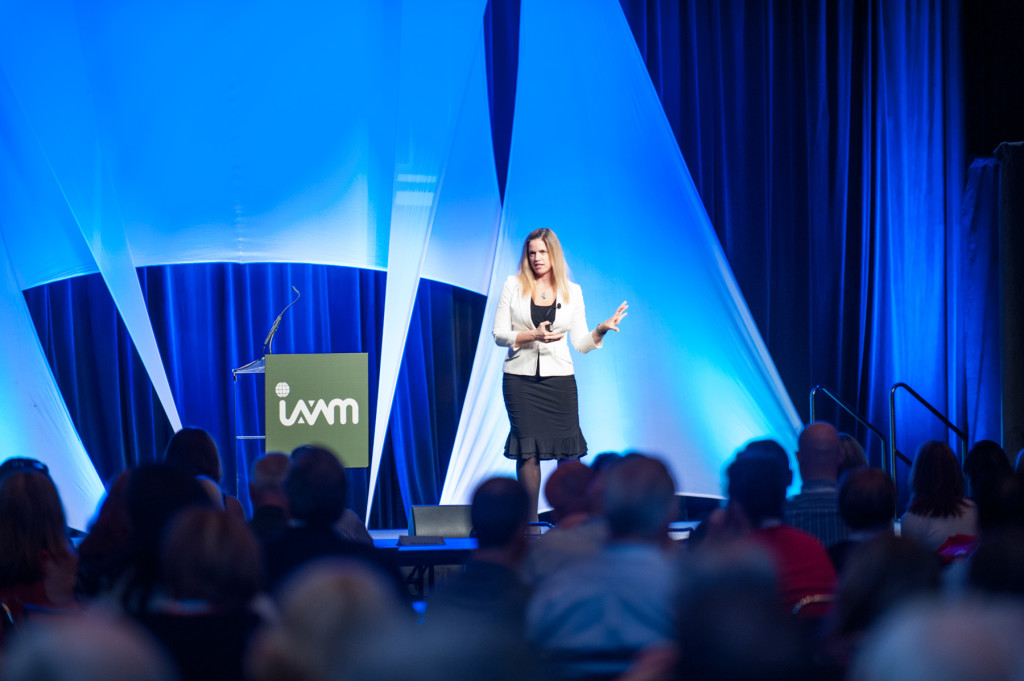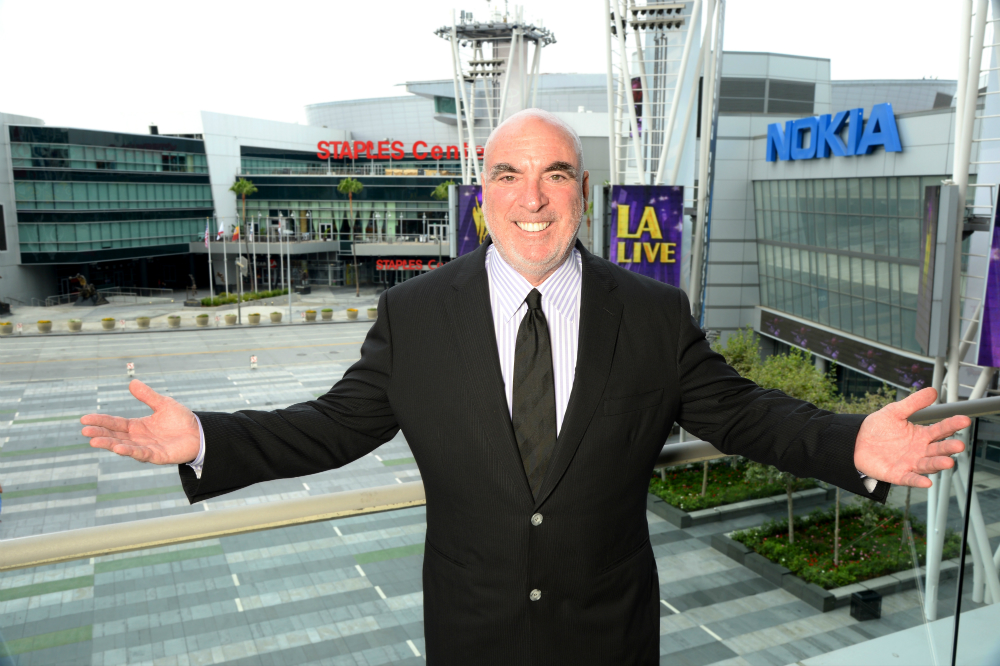VC14: Opening Keynote, Polly LaBarre, Urges More Questions
Polly LaBarre, co-author of Mavericks at Work: Why the Most Original Minds in Business Win and co-founder of Fast Company magazine, delivered the opening keynote address, Saturday, July 26, at VenueConnect 2014.
LaBarre challenged the attendees to ask themselves how they can create powerful connections with people.
“How do you generate innovative DNA at your workplaces? What is the walk of leadership today?” she asked.
One way to create an innovative culture is to have strategic clarity. You have to define your purpose.
“You have to advocate for a cause,” LaBarre said. “Purpose isn’t nice. It’s about sharpening your points.”
In the end, you want people to retell your purpose. This includes not only customers, but also employees.
“The most successful companies are the ones who have figured out how to unleash their employees’ potentials,” she said.
LaBarre’s presentation, sponsored by Gensler, was full of questions, and that was on purpose.
“You should always ask more questions than give answers,” she said. “Inquiry beats assertions all the time.”
Please read more about LaBarre in the February/March issue of FM magazine.
(Image: Orange Photography)
VC14: Legacy Project Lights Up Kids’ Faces (Photos)
There was a great turnout for the 2014 VenueConnect Legacy Project. This year, participants built bikes for the benefit of Neighborhood House, a local Portland charity. Fourteen bikes were built and two were anonymously donated after the event.
In addition to the great cause and team-building aspect of the project, the most moving moment was when the children came in to receive the bikes.
“Seeing the kids’ faces light up was amazing,” said Brian Stovall, director of facilities for the Frank Erwin Center in Austin, Texas. “It was great see the project’s tangible results. It was also great to see participation across the board. There were so many people from different states and in a variety of leadership roles. It truly represented our industry well, and I’d love to see the Legacy Project continue.”
Check out the photos below to see the project in action and some of the kids who received the bikes.
(Image: Orange Photography)
VC14: Golf, Wine, and Stunning Views (Photos)
VenueConnect attendees kept themselves busy on Friday with several activities that let them experience some of the best of Portland, while also helping raise funds for the IAVM Foundation. From a packed golf tournament to relaxing wine tours to a leadership dinner at Ponzi Vineyards ending with a beautiful sunset behind the Chehalem Mountains, everyone came away invigorated for the upcoming conference days.
“I loved learning about the history of the wines and the tastings at the vineyards,” said Randi Peters from VenuWorks. “WillaKenzie was my favorite, but all the wineries were very kind.”
It’s true, the hospitality in Portland is phenomenal. It’s definitely leaving a great impression on attendees.
Check out some of the photos from the events (including the IAVM tent at the Oregon Brewers Festival), courtesy of our official conference photographers, Orange Photography.
(Image: Orange Photography)
VC14: Demystifying Generational Differences
As more people continue working well into their 70s and 80s, the workplace becomes a multi-generational melting ground. Myths get mixed up with realities, and people start making assumptions about co-workers based on age.
One group that’s received the most blunt assumptions about itself is the Millennial generation. People in this generation are usually looked at as entitled, lazy, and flighty.
“The notion of entitlement is the one you read about most,” said Lauren Stiller Rikleen, president of the Rikleen Institute for Strategic Leadership and the author of You Raised Us – Now Work With Us: Millennials, Career Success, and Building Strong Workplace Teams. “They’re also labeled as not being loyal or committed to their jobs, and that they only want positive feedback.”
These labels are not always true, because every person is different and shouldn’t be defined by generation.
“People always complain about youth in the workplace,” Rikleen said. “But for Millennials, these complaints are at a different level and are more frequent.”
Rikleen will address these complaints and the myths around Millennials Monday, July 28, at 1:15 p.m. during her VenueConnect session, “Demystifying Generational Differences and Finding Common Ground to Ensure Workplace Success.”
The session, sponsored by Sodexo, will present practical recommendations to help other generations respond to the opportunities that Millennials bring to the workplace, how to motivate and inspire Millennials to navigate their career successes, and provide strategies for Millennials to employ that can help other generations see beyond the stereotypes.
“We need to understand what we’re seeing in the workplace,” Rikleen said. “For example, Millennials want feedback, and it doesn’t have to be positive. Instead of a year-end review, they want frequent updates about their performances.”
Rikleen said that attendees will learn some specific strategies for creating multi-generational teams at work.
“It’s wrong to make assumptions,” Rikleen said. “At this session, attendees will walk away with better abilities to separate myths from realities.”
(photo credit: reynermedia via photopin cc)
Lee Zeidman Takes on a New Title in an Expanded Role Atop AEG’s L.A. Live Flagship Venues
Congratulations to Lee Zeidman, who has been promoted to the newly created position of President, STAPLES Center. Zeidman will also simultaneously be elevated to President, Nokia Theatre L.A. LIVE, as well as President, L.A. LIVE, the downtown sports and entertainment district where the venues are located.
“I am truly honored and look forward to this next chapter in my career with AEG as president of STAPLES Center, Nokia Theatre, and L.A. LIVE,” Zeidman said. “Having been part of this venture since day one watching and participating in the revitalization of downtown Los Angeles, I could not be more eager to oversee the continued growth and success that these venues have in store. Additionally, I would not be where I am today without the hard work of the incredible full-time staff that work with me, as well as our world-class event staff and our partners and sponsors that keep these venues running day in and day out.”
Hired in 1998 as STAPLES Center’s first full-time employee, Zeidman will continue to oversee all aspects of operations and business development of each of the venues including event operations and production, guest services, booking, box office, event security, event staffing, guest relations facility presentation, food and beverage services, marketing, and communications.
“There is not a single individual in our industry who is better qualified than Lee Zeidman to manage our key flagship Los Angeles venues and the L.A. LIVE sports and entertainment district,” said Dan Beckerman, president and CEO at AEG. “STAPLES Center, Nokia Theatre, and L.A. LIVE are at the heart of AEG’s core business, and their success under Lee’s leadership has fueled the growth of AEG throughout the world.”
In addition to overseeing comprehensive relationships with anchor tenants the Los Angeles Kings, Los Angeles Lakers, Los Angeles Clippers, and Los Angeles Sparks franchises, Zeidman leads AEG’s overall event partnership associations with organizations such as The Recording Academy, ESPN, The NBA, Academy of Television Arts & Sciences, Dick Clark Productions, and 19 Entertainment among others who regularly partner with the venues to create and produce annual and special events.
As part of his expanded, multi-venue role, Zeidman will continue to work on behalf of AEG to partner with producers, promoters, leagues, agencies, and other entities to develop and create new programming and events for venues both within L.A. LIVE and AEG’s network of elite facilities worldwide.
Named to AEG’s newly formed Sr. Management Committee in 2013, Zeidman serves as a member of the Los Angeles Sports & Entertainment Commission’s Advisory Board and has been selected to serve as Trustee for the IAVM Foundation.
An original member of STAPLES Center’s design and development team, Zeidman has received numerous awards for excellence including Pollstar’s 2008 Facility Executive of the Year while venues under his guidance have also been honored multiple times including STAPLES Center twice being named Arena of the Year and Nokia Theatre receiving Pollstar’s Theatre of the Year award in 2008, 2009, and 2010.
“In addition to guiding the day-to-day activities of every aspect of these facilities, Lee will continue to play a significant role in the creation of new content for our venues,” Beckerman said. “As a member of our executive management committee, Lee’s experience, expertise, and valuable voice will help to guide the overall strategic direction of the company.”
(Image: STAPLES Center)
Do you want to receive a Front Row News weekly digest?
Categories
- Allied (861)
- Architecture (147)
- Arenas (747)
- Career (897)
- Convention Centers (895)
- Education (623)
- Events (1,544)
- Food & Beverage (193)
- Foundation (113)
- Guest Experience (1,496)
- Industry News (2,270)
- Leadership (1,888)
- Marketing (150)
- Membership (2,000)
- Music (213)
- Performing Arts Centers (454)
- Professional Development (409)
- Research (127)
- Safety & Security (442)
- Sports (763)
- Stadiums (608)
- Student (159)
- Technology (516)
- Ticketing (92)
- Touring (82)
- Trends (364)
- Uncategorized (743)
- Universities (218)
- Video (25)
- Young Professional (198)
Twitter Feed
- Twitter feed loading
Recent Posts
- Venuworks and ATG Entertainment Selected to Manage Fresno Convention and Entertainment Center
- Seattle Convention Center Announces Strategic Leadership Appointment and Growth Initiatives for 2026
- Peggy Daidakis Humbly Made Convention Center History
- Welcome to Our Newest Members
- New Member Benefit! IAVM Partners with Advantage Training to Elevate Staff Readiness and Guest Experience
Categories
- Allied
- Architecture
- Arenas
- Career
- Convention Centers
- Education
- Events
- Food & Beverage
- Foundation
- Guest Experience
- Industry News
- Leadership
- Marketing
- Membership
- Music
- Performing Arts Centers
- Professional Development
- Research
- Safety & Security
- Sports
- Stadiums
- Student
- Technology
- Ticketing
- Touring
- Trends
- Uncategorized
- Universities
- Video
- Young Professional
Archives
- December 2025
- November 2025
- October 2025
- September 2025
- August 2025
- July 2025
- June 2025
- May 2025
- April 2025
- March 2025
- February 2025
- January 2025
- December 2024
- November 2024
- October 2024
- September 2024
- August 2024
- July 2024
- June 2024
- May 2024
- April 2024
- March 2024
- February 2024
- January 2024
- December 2023
- November 2023
- October 2023
- September 2023
- August 2023
- July 2023
- June 2023
- May 2023
- April 2023
- March 2023
- February 2023
- January 2023
- December 2022
- November 2022
- October 2022
- September 2022
- August 2022
- July 2022
- June 2022
- May 2022
- April 2022
- March 2022
- February 2022
- January 2022
- December 2021
- November 2021
- October 2021
- September 2021
- August 2021
- July 2021
- June 2021
- May 2021
- April 2021
- March 2021
- February 2021
- January 2021
- December 2020
- November 2020
- October 2020
- September 2020
- August 2020
- July 2020
- June 2020
- May 2020
- April 2020
- March 2020
- February 2020
- January 2020
- December 2019
- November 2019
- October 2019
- September 2019
- August 2019
- July 2019
- June 2019
- May 2019
- April 2019
- March 2019
- February 2019
- January 2019
- December 2018
- November 2018
- October 2018
- September 2018
- August 2018
- July 2018
- June 2018
- May 2018
- April 2018
- March 2018
- February 2018
- January 2018
- December 2017
- November 2017
- October 2017
- September 2017
- August 2017
- July 2017
- June 2017
- May 2017
- April 2017
- March 2017
- February 2017
- January 2017
- December 2016
- November 2016
- October 2016
- September 2016
- August 2016
- July 2016
- June 2016
- May 2016
- April 2016
- March 2016
- February 2016
- January 2016
- December 2015
- November 2015
- October 2015
- September 2015
- August 2015
- July 2015
- June 2015
- May 2015
- April 2015
- March 2015
- February 2015
- January 2015
- December 2014
- November 2014
- October 2014
- September 2014
- August 2014
- July 2014
- June 2014
- May 2014
- April 2014
- March 2014
- February 2014
- January 2014
- December 2013
- November 2013
- October 2013
- September 2013
- August 2013
- July 2013
- June 2013
- May 2013
- April 2013
- March 2013
- February 2013
- January 2013
- May 2012
- March 2012
- December 2011
- November 2011
- October 2011
Recent Comments
- Frank Bradshaw, Ph.D., CVE on John Meyer, CVE, a Tireless Advocate of Certification for Venue Professionals, Has Died
- Neil Sulkes on Hilary Hartung, Friend to Many in Venue Marketing, Has Left Us
- Jason Parker, CVE on The Devastation of Hurricane Helene and How We Can Support One Another
- Larry Perkins on Touhey Testifies Against Speculative Ticketing Before Congressional Subcommittee
- Peter Secord on Major Players for Planned Elkhart Amphitheater Were in the Mix at VenueConnect








































